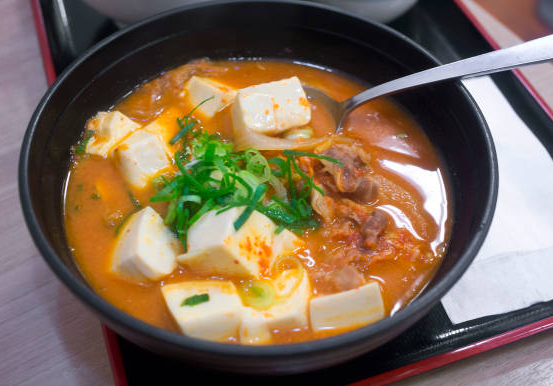All around Fermented Kimchi is Key
The best kimchi to use for making this stew is a napa cabbage kimchi—one that has been sitting in the refrigerator for some time. It ought to be quite sharp, astounding, and at times even bubbly. Both the green napa leaves and the red bean stew powder will have obscured.
Kimchi keeps on aging as it sits and over the long haul its flavor creates to something extensively more complicated. This aged flavor is fundamental to kimchi jjigae.
Assuming that your pork tummy is greasy set aside some additional effort to deliver it, which means to cook a portion of the fat out of the meat prior to adding the remainder of the fixings. I suggest cooking it over medium hotness for around 10 minutes. Try not to surge and cook the pork on a high hotness or it might get extreme.
The Best Tofu for Kimchi Jjigae
Firm tofu is the thing that’s regularly utilized in kimchi jjigae in light of the fact that it won’t fall to pieces effectively, despite the fact that I have utilized gentler tofu.
I purchase a Korean brand of natural tofu called Pulmuone, which I’ve just found in Korean business sectors. Nonetheless, I see different brands of firm tofu accessible these days at my nearby grocery store. Go ahead and utilize any brand you like.
Instructions to Serve Kimchi Jjigae
It’s likewise normal to serve this stew with an assortment of Korean side dishes called banchan. I particularly prefer to combine kimchi jjigae with this simple Sigeumchi Namul (prepared spinach), which is light and invigorating, an extraordinary differentiation to the rich greasy meat and hot stock.
Fixing Swaps and Substitutions
⦁ Kimchi jjigae is an adaptable dish. You can utilize specific fixings that are as of now accessible in your storage space.
⦁ Assuming pork tummy isn’t accessible; utilize a cut of pork that has some fat like pork shoulder or pork butt. Certain individuals even use Spam or bacon.
⦁ If your kimchi doesn’t have a solid, crazy smell when you open the container or there isn’t enough kimchi brackish water left in the container, add some apple juice vinegar to compensate for the absence of acridity.
⦁ While firm tofu is the norm for kimchi jjigae, you can utilize tofu of shifting levels of immovability, from smooth to additional firm.
⦁ The outcome is something almost identical to dashi, a Japanese stock used to make miso soup.
Ingredients
⦁ For the rice
⦁ 2 cups short or medium grain rice, washed and depleted
⦁ 2 cups water
⦁ For the stew
⦁ 1 pound pork tummy, cut into 1 1/2 x 1/4-inch pieces
⦁ 2 cups kimchi
⦁ 1/3 cup gochujang
⦁ 1 tablespoon gochugaru
⦁ 2 teaspoons sugar
⦁ 4 1/2 cups water
⦁ Soy sauce or fish sauce, to taste
⦁ 1 (16-ounce) bundle firm tofu, depleted and cut into 1 1/2 x 1/4-inch boards
⦁ For the enhancement
⦁ 1 tablespoon toasted sesame oil (discretionary)
⦁ 1 teaspoon toasted sesame seeds (discretionary)
⦁ 2 scallions, managed and daintily cut
Strategy
Make the rice:
In a medium pan over medium-low to low hotness, consolidate the rice and water. Actually take a look at the pot around 10 minutes in to ensure it’s not bubbling over. Assuming this is the case, bring down the hotness and keep cooking.
Turn the hotness off and keep the top on until prepared to serve.
Cook the pork:
In a medium Dutch stove set over medium hotness, add the pork and cook, blending once in a while, until it begins to deliver fat, around 10 minutes. It ought to lose the greater part of its pink tone however it ought not brown. You can add a little oil in the pot to kick it off yet I don’t think that it is vital.
Set up the kimchi:
Utilizing your hands, crush the fluid (the brackish water) out of the kimchi into a little bowl. You ought to have around 1/4 cup of kimchi brackish water. If not, scoop some out of the kimchi container. Put the brackish water away.
Slash the kimchi into scaled down pieces.
Add the flavors:
Add the slashed kimchi, gochujang, gochugaru (add to taste assuming that you incline toward a less fiery stew), and sugar to the pork and blend well. Cook, mixing frequently, until the combination looks shiny and sassy, around 3 minutes.
Adding fixings to a Dutch stove to make hot kimchi and pork tummy stew
Overhead perspective on a Dutch broiler with fixings combined as one for fiery kimchi and pork midsection stew.
Add the fluids:
Add the held kimchi saline solution and the water and heat to the point of boiling. Diminish the hotness to keep a stew for around 20 minutes for the flavors to merge.
Taste the stew and on the off chance that you’d like, add a shower of soy sauce or fish sauce to taste.
Pork midsection and kimchi jjigae in a dutch broiler.
Add the tofu:
Organize the tofu, marginally shingled, on top of the stew. They might sink totally into the stew however that is fine. Allow it to warm through, around 3 minutes.
Decorate the stew and serve:
In the event that utilizing, shower with sesame oil and top with sesame seeds and scallions. Cushion the rice with a spoon or a fork and serve close by the stew.







